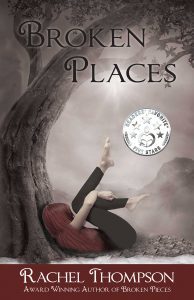How To Effectively Balance PTSD and Real Life
Is it possible to balance PTSD and real life? It is, if you realize you have it, know what to look for, and get the help you need.
It wasn’t until a few years ago that I realized, after dealing with migraines for over twenty years, they could somehow be related to the childhood sexual abuse (CSA) I experienced when I was eleven. No neurologist had ever asked about my past. Why would I think there would be a connection?
I started therapy in my mid-thirties for postpartum depression – my shrink was great. He helped me deal with the here and now of anxiety and depression. Triage, if you will. We eventually delved into my past and he diagnosed me as having PTSD from the CSA. (I wrote a post all about migraines and treatment here if you’d like to start with that post. That’s not what this post is about.)
You have to understand – I had no concept whatsoever why I hated crowds and noise, why going to Disneyland with my husband (at the time) and kids made me cry and tremble (it’s supposed to be the happiest place on earth, right?), or why slamming doors and drawers (my ex was a slammer) made me jump as if I were in a horror movie.
I pushed myself through these experiences for years, not realizing how much worse that made the hyper-vigilance. How would I know? While my shrink was helpful in many ways, we didn’t discuss a connection between PTSD and my current chronic pain.
Migraines have had such a huge effect on my life since my late-twenties — how can I not have known about this PTSD link? It’s mind-boggling.
Fast forward another ten years or so: I’ve written and released Broken Pieces (in 2013), moved to a new city, separated from my now ex-husband, and started seeing a new trauma-informed therapist who shows me all kinds of studies showing the link between PTSD and chronic pain. (Not every survivor of sexual trauma gets PTSD – typically, it’s anywhere from 30% to 50%; Source: Harvard School of Public Health).
Let’s talk more about PTSD, pain, and how to balance it all.
Defining PTSD
Post-Traumatic Stress Disorder is defined as a state of extreme anxiety and hypervigilance which begins after some type of traumatic experiences such as a rape, military combat, or natural disaster.
The symptoms of PTSD may include reliving the traumatic event over and over again, avoiding people or places that remind you of the trauma, or exhibiting symptoms of the flight or fight reaction. (Source: Very Well Mind.) (Freezing is also a natural response to trauma. To learn more about the three types of freezing, read this informative article from Jim Hopper, Ph.D. in Psychology Today.)
PTSD and Pain
It’s well-known that people with PTSD are at higher risk of heart disease, immune disorders, eating disorders, addiction, and depression. But did you know that we’re at higher risk of pain issues (e.g., migraines, back pain, fibromyalgia) as well? Most survivors don’t. I didn’t. In fact, most physicians and other health-care practitioners don’t know (or at least don’t ask about it when taking a patient’s history).
My own experience was fairly unique, in that I was a Big Pharma rep – I called on dozens of neurologists as a rep. I saw several as a patient. One, in particular, was ‘the guy’ – well-known internationally as The Migraine Doctor. Not once did he ask about my past or PTSD. Just threw a triptan* at me and said ‘if it works, you have migraines. If it doesn’t, you don’t. And don’t smoke. You’ll stroke out and die.’ Yea, charming.
*Triptans are formally known as serotonin receptor agonists. Triptan drugs work like a brain chemical called serotonin. This helps quiet down overactive pain nerves. In other words, triptans reverse the changes in your brain that caused your migraine.
Point is: with all of the training (and I sold neurology and migraine meds), with all my interactions with internists, neuros, GPs, FPs, nurses, PAs, etc., not once did we discuss past trauma as a connection to pain. This is major gap.
Tip: Find a physician you’re comfortable with, and tell him/her about your sexual trauma. I’m very open about it now with all my healthcare practitioners. They are welcoming, and it often changes their treatment plan.
Studies show that pain is one of the most common physical problems reported by people with PTSD. This finding holds true no matter what types of traumatic events they experienced—for example, a motor vehicle accident, physical assault, or combat injury. People with PTSD are also more likely to report pain-related disability.
In one study of volunteer firefighters with PTSD, approximately 50% were having pain (mainly back pain) compared with only about 20% of firefighters without PTSD.
In two other studies, from 20% to 30% of patients with PTSD had frequent and chronic pain symptoms.
You can also look at this situation in reverse: Many patients with chronic pain problems also have PTSD. In fact, from 10% to 50% of people getting treatment for chronic pain have PTSD as well. These rates of PTSD are higher than those found in the general population. (Source: VeryWellMind)
Why is this? Think about it. If you are tensed up due to hyper-vigilance, you may suffer from tension headaches which can lead to migraines *raises hand*. From this same article:
Some symptoms of PTSD may cause pain. For example, PTSD-related hyperarousal symptoms often cause tense muscle pain that can become chronic. More below on hyperarousal (and no, it’s not sexual, ya dirty creatures).

…and the light bulb goes on
Three Main Symptom ‘Groups’ of PTSD
PTSD is complicated. Though it can affect each person in many different ways, there are identifiable characteristics which are grouped in this way:
Re-experiencing: manifests as if we are reliving the event(s) through flashbacks, dreams/nightmares, or intrusive thoughts. There isn’t a day that goes by where I don’t experience some kind of flashback to when I abused as a child. The thoughts pop up out of nowhere during the course of my day.
Sometimes I expect them if I’m working on my books or poetry, or watching a movie or reading a book that has that kind of content. Most of the time, though, these flashbacks are unwanted visitors that come and go.
Very rarely do these flashbacks trigger me, and my guess is I’ve become so used to them, I just go on about my day. Once in a while, though, I will be triggered out of nowhere.
Tip: What triggers you may be different than what triggers me. Make note of past triggers and discuss with your therapist. Work through them IF you feel it’s okay. There is a vast difference between being upset and being triggered. Ignore social media’s definition. Trust your instincts.
Avoidance: is exactly what you think it means – consciously or subconsciously changing your behavior to avoid scenarios associated with the event(s) or losing interest in activities you enjoy. It can also mean ignoring our health and mental health needs because that would mean acknowledging or talking about our experiences, which can be so shameful and debilitating for many survivors, they’d rather suffer in pain than seek help.
Shame is powerful. So are you. Remember, you’ve done nothing wrong. If you’re in pain, get the help you deserve.
Hyperarousal: okay, buckle up for this one. Hyperarousal can take many forms. Here’s a list from Medical News Today:
find it hard to go to sleep or stay asleep
feel irritable and quickly lose their temper
find it hard to concentrate
constantly feel on-guard (hypervigilance)
be more impulsive than usual
feel like their muscles are more tense than usual
feel pain more easily
feel their heart beating faster than usual
feel jumpy and be startled easily
breathe more quickly or less deeply than usual
have flashbacks about a traumatic event
Hyperarousal can cause trouble sleeping, anger, concentration issues, and impulsiveness (as well as what I referred to earlier: avoidance and re-experiencing). Therapy can take many forms here and is so incredibly helpful in teaching us ways to cope with these issues.
Dissociation
Not all survivors experience dissociation, which experts explain as the mind escaping the body until the assault is over. I experienced it. I didn’t know because I didn’t have the language for it. I simply watched myself from a tree while the abuse occurred each time, waiting for it to be over. After that, I dissociated frequently throughout my childhood and teen years, mostly in times of stress, until I could do so on demand.
I still can – quite the party trick.
For me to dissociate without being aware is rare, though it happened recently this past summer at a small, local art gallery where my daughter interned. Hot, crowded, loud — I completely checked out mentally, yet I had no idea. I grew quiet, my eyes were glazed and unblinking as I rushed from here to there.
My guy figured it out and hustled me out of there, but even he didn’t recognize what happened at first except that I acted strangely. I didn’t have any way to tell him it was happening because I didn’t know myself.
Tip: Talk to those closest to you about dissociation. Tell them what happens when you dissociate so they can look for clues in case you’re unable to identify when you’re in it. Let people help you.
Triggers
What does it mean to be “triggered?” In recent years, people on the internet casually (and oftentimes, callously) refer to being triggered, particularly in response to political conversations. Beyond that, survivors themselves often confuse triggers with stress. Stress is a normal part of our everyday lives and everyone experiences stress; triggers are specifically associated with anxiety.
From a mental health perspective, being “triggered” more narrowly refers to the experience of people with PTSD re-experiencing symptoms of a traumatic event (such as exposure to actual or threatened death, serious injury, or sexual violation) after being exposed to a trigger that is a catalyst or reminder. (Source: VeryWellMind)
It can be hard to tell the difference for survivors if you’re constantly in a state of anxiety and worry, and feel as if everything is a trigger for you. This is why seeking mental health services is crucially important. Most of us are ill-equipped to know the difference.
I’m not a shrink, yet here are some handy tips I’ve learned to use when faced with situations you’re not sure how to handle:
Is what’s bothering you somehow linked to your past abuse in some way? Is it causing a flashback, avoidance, or hypervigilance (as mentioned above)? Then that’s likely a trigger.
Alternatively, if you find yourself angry at what somebody said, that’s a normal stress reaction and you are likely not triggered. You are a normal human having a normal emotional reaction to stress.
Tip: Whenever you feel stressed out, write down what it is specifically that’s bothering you. Is it a daily activity, someone’s voice, specific foods, the time of day? Journaling can be extremely helpful in determining what is a stressor and what is a trigger.
There is a lot to manage when you have PTSD as a result of sexual trauma (or any kind of trauma). Don’t diagnose yourself. Get help. You deserve it. We all deserve it. We deserve love, compassion, and support.
And always remember: you did nothing wrong.
Read more about Rachel’s experiences in the award-winning book, Broken Pieces.
She goes into more detail about living with PTSD and realizing the effects of how being a survivor affected her life in
Broken Places, available now on Amazon.


The post How To Effectively Balance PTSD and Real Life appeared first on Rachel Thompson.




